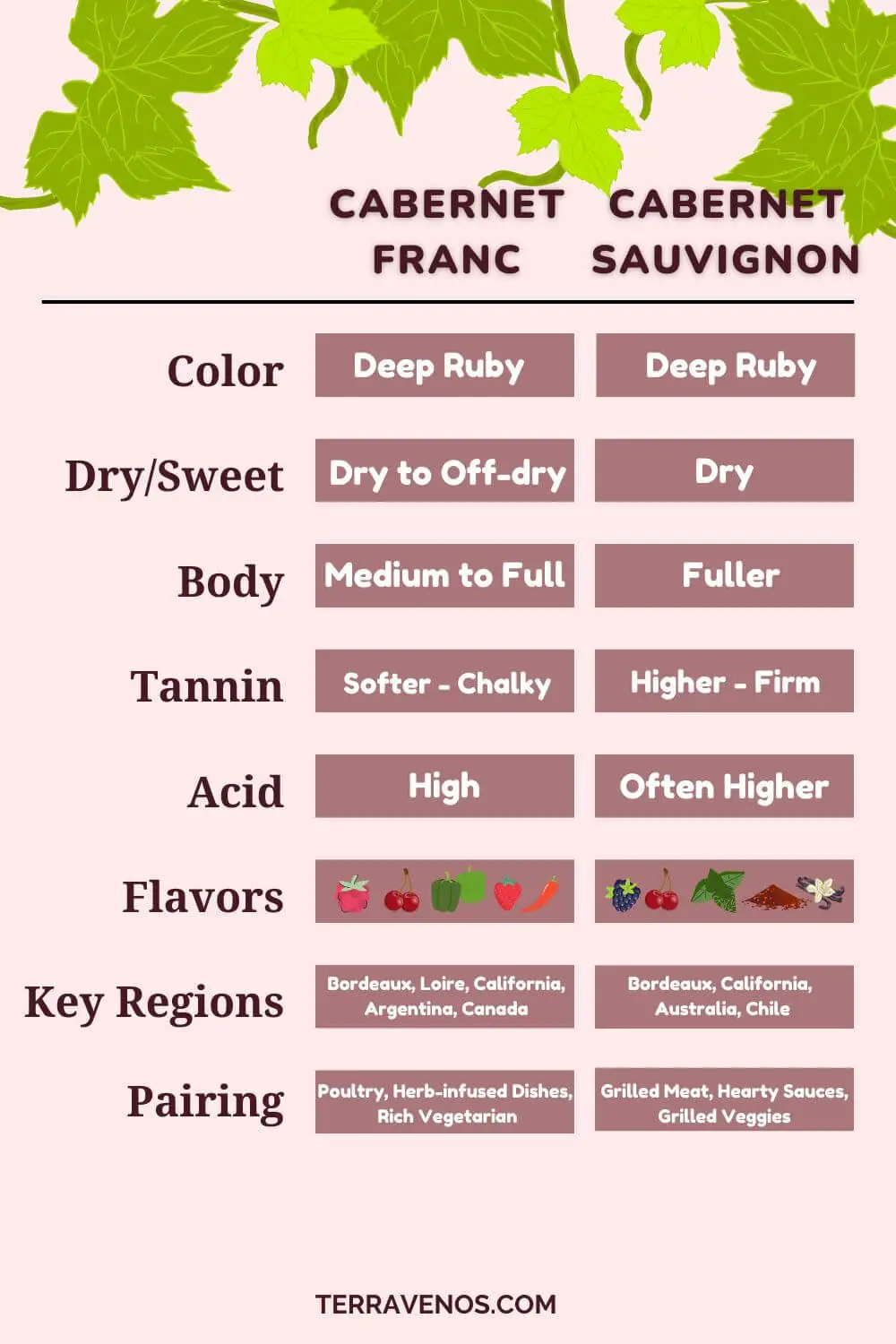
When it comes to red wines, there are various options to explore, each with its distinct characteristics.
Cabernet Sauvignon presents a robust body with bold notes of black fruits and rich tannins. On the other hand, Cabernet Franc offers a medium body, showcasing vibrant red fruit flavors and a touch of herbal complexity. While Cabernet Sauvignon is more widely available and can range in price, both wines can be enjoyed within the $15-$20 USD range.
These wines provide a fascinating opportunity to compare and appreciate unique red wine flavor profiles, origins, and characteristics.
- Cabernet Sauvignon Basics: A Classic Bordeaux Varietal
- Cabernet Franc Basics: Elegance with Herbal Nuances
- Wine Comparison: Cabernet Sauvignon vs. Cabernet Franc
- Cabernet Sauvignon vs. Cabernet Franc Winemaking
- Cabernet Sauvignon vs. Cabernet Franc: Food Pairings and Serving Temperature
- Which Is More Expensive, Cabernet Sauvignon vs. Cabernet Franc
- Final Thoughts – Cabernet Sauvignon or Cabernet Franc?
Fun Wine Fact: Cabernet Sauvignon is actually a genetic cross between Cabernet Franc and Sauvignon Blanc, making Cab Sav the child grape of Cabernet Franc.
Cabernet Sauvignon Basics: A Classic Bordeaux Varietal
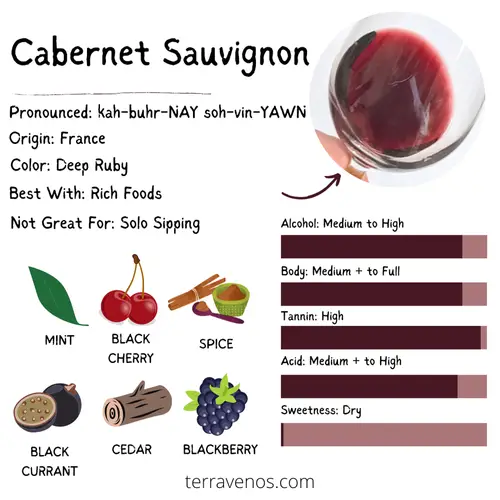
Cabernet Sauvignon, originating from the Bordeaux region in France, has gained global recognition for its bold and full-bodied nature. It is known for its deep color, firm tannins, and complex flavor profile. Cabernet Sauvignon often exhibits notes of blackcurrant, blackberry, cedar, and hints of vanilla. It ages well and can develop more complexity over time. (Here’s a deep-dive into Cabernet Sauvignon wines.)
Fun Wine Fact: Cabernet Sauvignon is often blended with other grape varieties, such as Merlot and Cabernet Franc, to create Bordeaux-style blends.
Being one of the most widely planted and recognized red wine grapes, Cabernet Sauvignon is produced in numerous regions around the world, including California, Australia, and Chile.
Each region imparts its unique characteristics to the wine, resulting in diverse expressions of this noble grape.
Helpful Tip: If you’re new to wine tasting, here’s a quick guide to help you navigate unfamiliar wines.
Cabernet Franc Basics: Elegance with Herbal Nuances
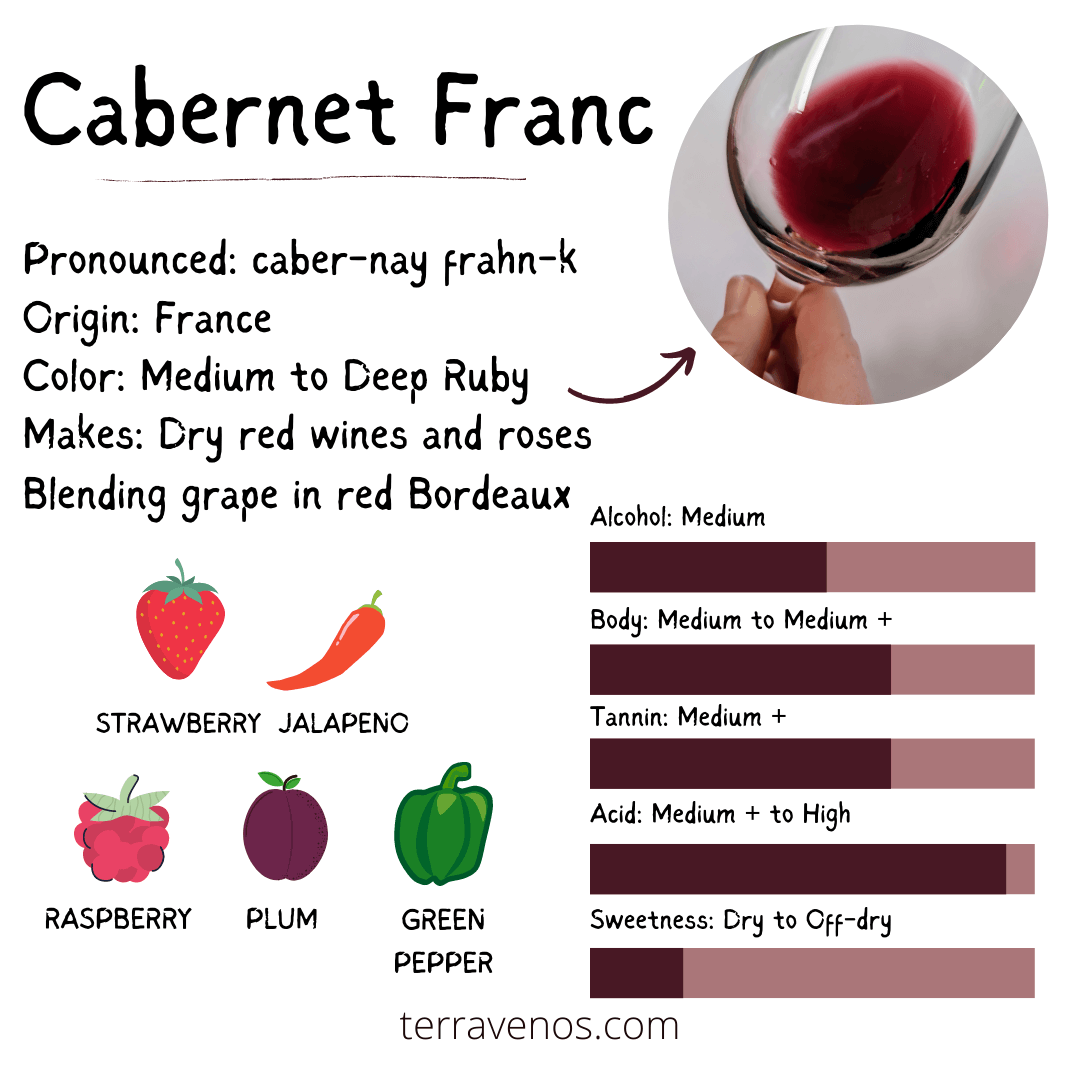
Cabernet Franc, a parent grape of Cabernet Sauvignon, offers its own distinctive charm. Originating from the Loire Valley in France, Cabernet Franc is known for its medium body, vibrant acidity, and herbal complexity.
It showcases flavors of red fruits like raspberry and red currant, often accompanied by hints of bell pepper, tobacco, and violets. (Here’s a deep-dive into Cabernet Franc wines.)
Cabernet Franc has gained recognition beyond its French origins, with plantings found in regions such as California, Argentina, and Canada. It thrives in cooler climates and can produce elegant wines with a touch of Old World charm.
Fun Wine Fact: Cabernet Franc is one of the main grape varieties used in the production of Chinon wines in the Loire Valley.
Wine Comparison: Cabernet Sauvignon vs. Cabernet Franc
Here’s a quick side-by-side that covers the most common styles of Cabernet Sauvignon and Cabernet Franc.
Cabernet Sauvignon Wine Profile:
- Sweetness: Cabernet Sauvignon wines are typically produced in a dry style, offering minimal residual sugar.
- Alcohol: Cabernet Sauvignon wines generally have a moderate to high alcohol content, ranging from around 13% to 15% ABV.
- Body: Known for its full-bodied nature, Cabernet Sauvignon provides a rich and powerful drinking experience.
- Tannins: Cabernet Sauvignon wines often have firm tannins that contribute to their structure and aging potential.
- Flavor and Aroma Intensity: Cabernet Sauvignon exhibits intense flavors and aromas of black fruits, such as blackcurrant and blackberry, with underlying notes of cedar and vanilla.
- Flavors: The flavor profile often includes blackcurrant, blackberry, dark chocolate, tobacco, and hints of vanilla and cedar.
Cabernet Franc Wine Profile:
- Sweetness: Cabernet Franc wines lean towards dryness, offering a range of dry to off-dry styles.
- Alcohol: Cabernet Franc wines typically have a moderate alcohol content, similar to Cabernet Sauvignon, ranging from around 13% to 14% ABV.
- Body: Cabernet Franc is known for its medium body, providing a balanced and approachable drinking experience.
- Tannins: Cabernet Franc wines usually have softer tannins compared to Cabernet Sauvignon, resulting in a smoother mouthfeel.
- Flavor and Aroma Intensity: Cabernet Franc showcases vibrant red fruit flavors, such as raspberry and red currant, with herbal nuances of bell pepper and tobacco.
- Flavors: The flavor profile often includes red fruits, bell pepper, tobacco, violets, and a touch of spice.
Helpful Tip: If you’re unsure about serving temperatures, here’s a breakdown of wine serving temperatures for different wine styles and occasions.
Are Cabernet Sauvignon and Cabernet Franc Similar?
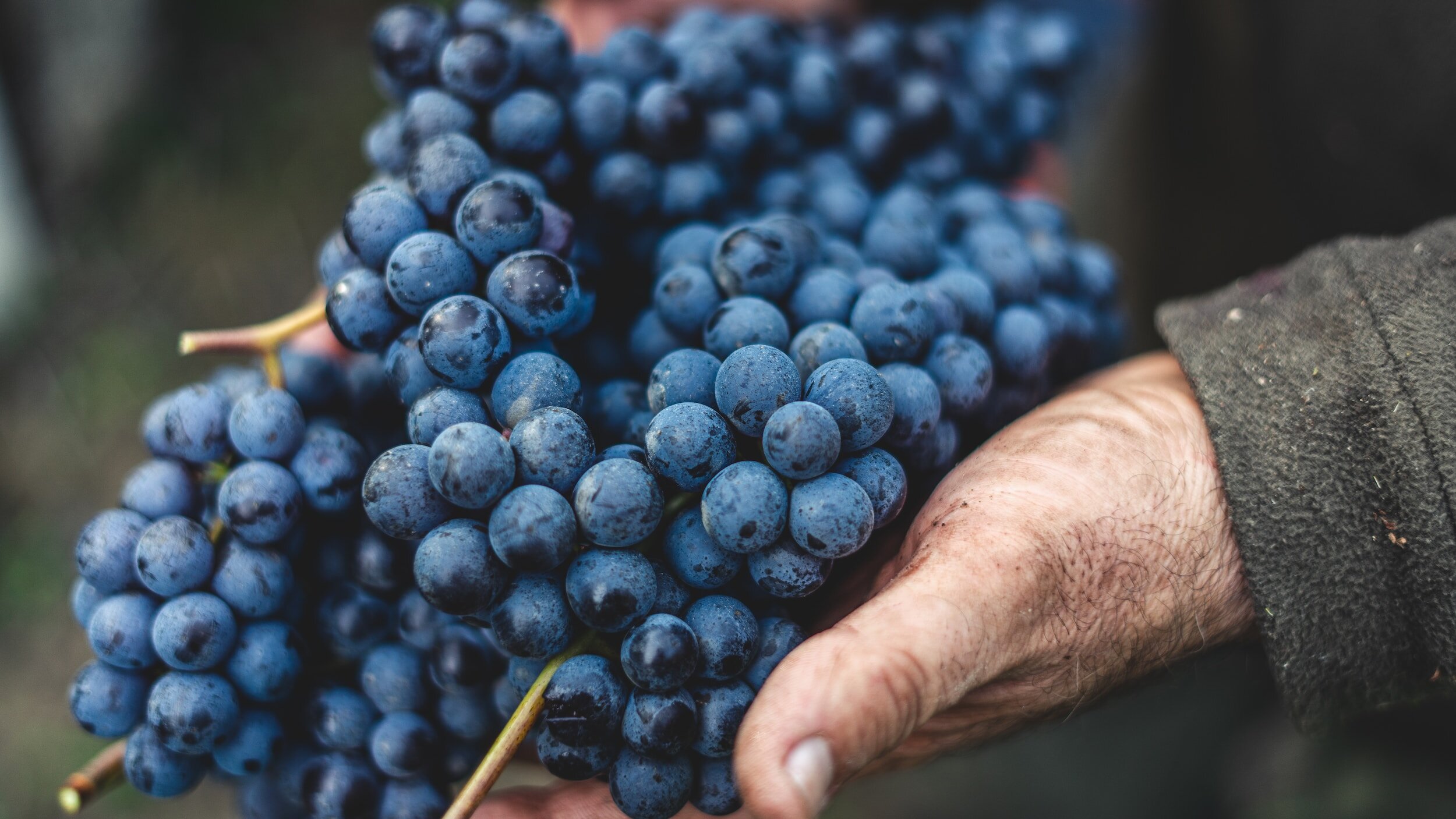
Cabernet Sauvignon and Cabernet Franc share certain characteristics. Both wines exhibit rich flavors of blackcurrant and red fruits, making them suitable for pairing with grilled meats and hearty dishes. If you enjoy Cabernet Sauvignon, you’re likely to appreciate Cabernet Franc as well.
What Is the Difference Between Cabernet Sauvignon and Cabernet Franc?
Cabernet Sauvignon tends to have a fuller body and more intense black fruit flavors, accompanied by pronounced tannins. Cabernet Franc offers a medium body with vibrant red fruit flavors and herbal nuances, often with softer tannins. Cabernet Franc often has a lighter flavor profile than Cabernet Franc but tends to be more herbaceous.
Fun Wine Fact: Cabernet Franc and Cabernet Sauvignon are often blended together in Bordeaux wines.
Cabernet Sauvignon vs. Cabernet Franc Winemaking

Both Cabernet Sauvignon and Cabernet Franc undergo similar winemaking techniques to enhance their flavors and structure. Oak aging is commonly employed to enhance the wines’ complexity and add subtle oak influences for more premium wines.
Moreso than with Cabernet Sauvignon, winemakers will often opt to age Cabernet Franc in stainless steel or neutral oak barrels to help preserve the wine’s pure fruit flavors and aromas (and it’s less expensive and Cabernet Franc doesn’t always command the prices of Cabernet Sauvignon).
Helpful Tip: Here’s what you need to know about oak aging and wine.
Winemakers also experiment with blending and aging methods for both wines to create unique expressions in your glass.
Cabernet Sauvignon vs. Cabernet Franc: Food Pairings and Serving Temperature

- Cabernet Sauvignon’s bold flavors and robust structure make it an excellent companion for grilled steaks, grilled mushroom dishes, and aged cheeses.
- Cabernet Franc, with its vibrant acidity and herbal notes, pairs exceptionally well with roasted poultry, herb-infused dishes, and vegetarian cuisine.
Discover: Cabernet Sauvignon Cheese Pairing Guide
Cabernet Sauvignon and Cabernet Franc: Serving Temperature
| Wine | Serving Temperature Range |
|---|---|
| Cabernet Sauvignon | 60-65°F (16-18°C) |
| Cabernet Franc | 55-60°F (12-16°C) |
Both Cabernet Sauvignon and Cabernet Franc are best served at a slightly cool temperature. It is recommended to store them in a cool place to reach the ideal temperature. Cabernet Sauvignon benefits from some aeration, so decanting it before serving can enhance its flavors.
Which Is More Expensive, Cabernet Sauvignon vs. Cabernet Franc
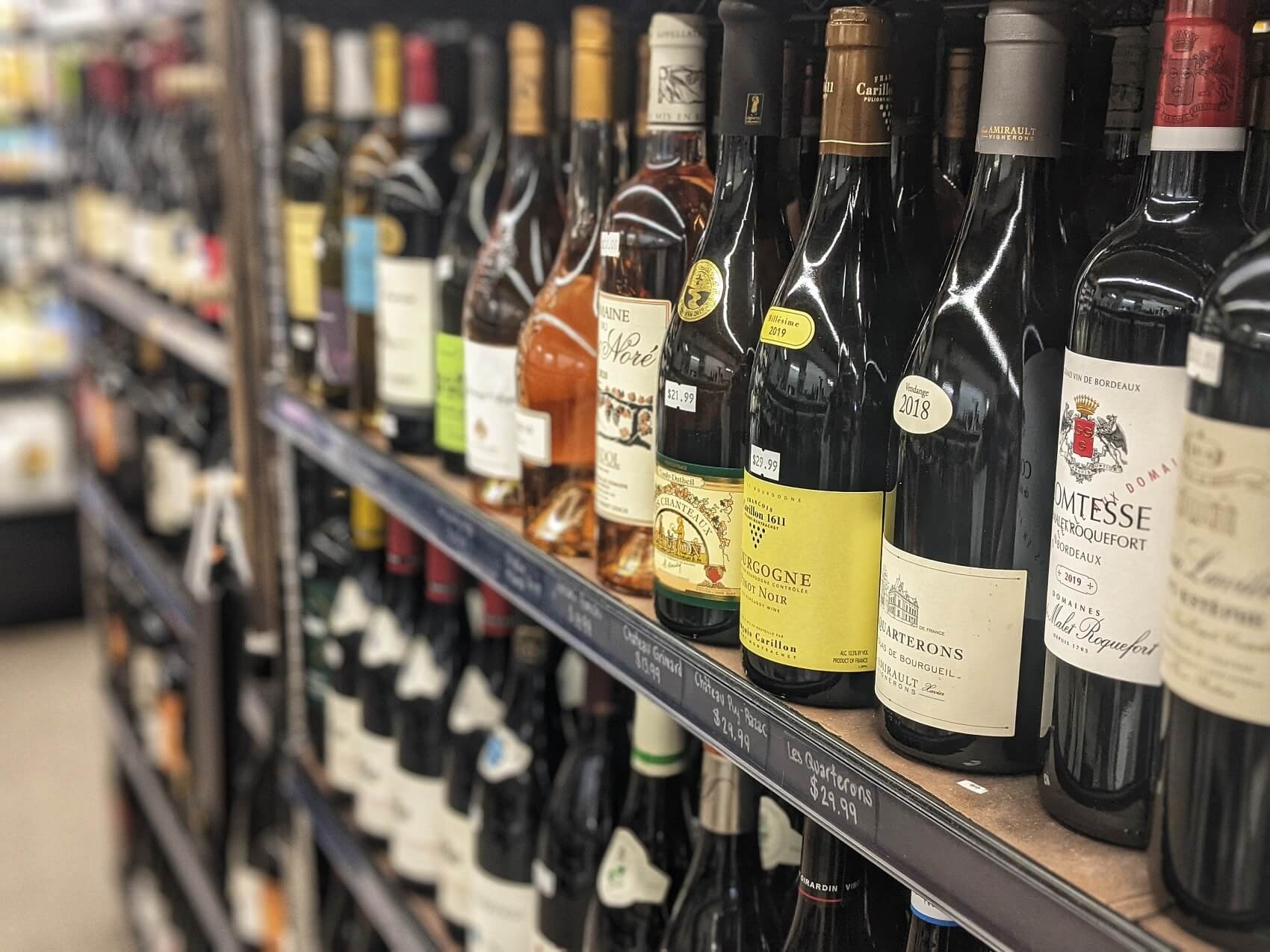
When comparing the prices of Cabernet Sauvignon and Cabernet Franc, it’s natural to wonder about their relative costs.
Cabernet Sauvignon Cost:
- Entry-level Cabernet Sauvignon wines are often priced between $10 and $20 per bottle, offering accessible options for everyday enjoyment.
- If you’re looking for premium selections from renowned producers or specific regions, prices can range from $30 to $100 or more.
Cabernet Franc Cost:
- Similar to Cabernet Sauvignon, entry-level Cabernet Franc wines fall within a similar price range, typically ranging from $15 to $25 per bottle. These wines provide an excellent introduction to the varietal’s unique characteristics.
- Premium Cabernet Franc wines from distinguished appellations or limited-production offerings can have prices starting from $40 and reaching upwards of $100.
Discover More:
Cabernet Sauvignon vs Merlot
Cabernet Sauvignon vs Malbec
Cabernet Sauvignon vs Chardonnay
Cabernet Sauvignon or Pinot Noir?
Final Thoughts – Cabernet Sauvignon or Cabernet Franc?
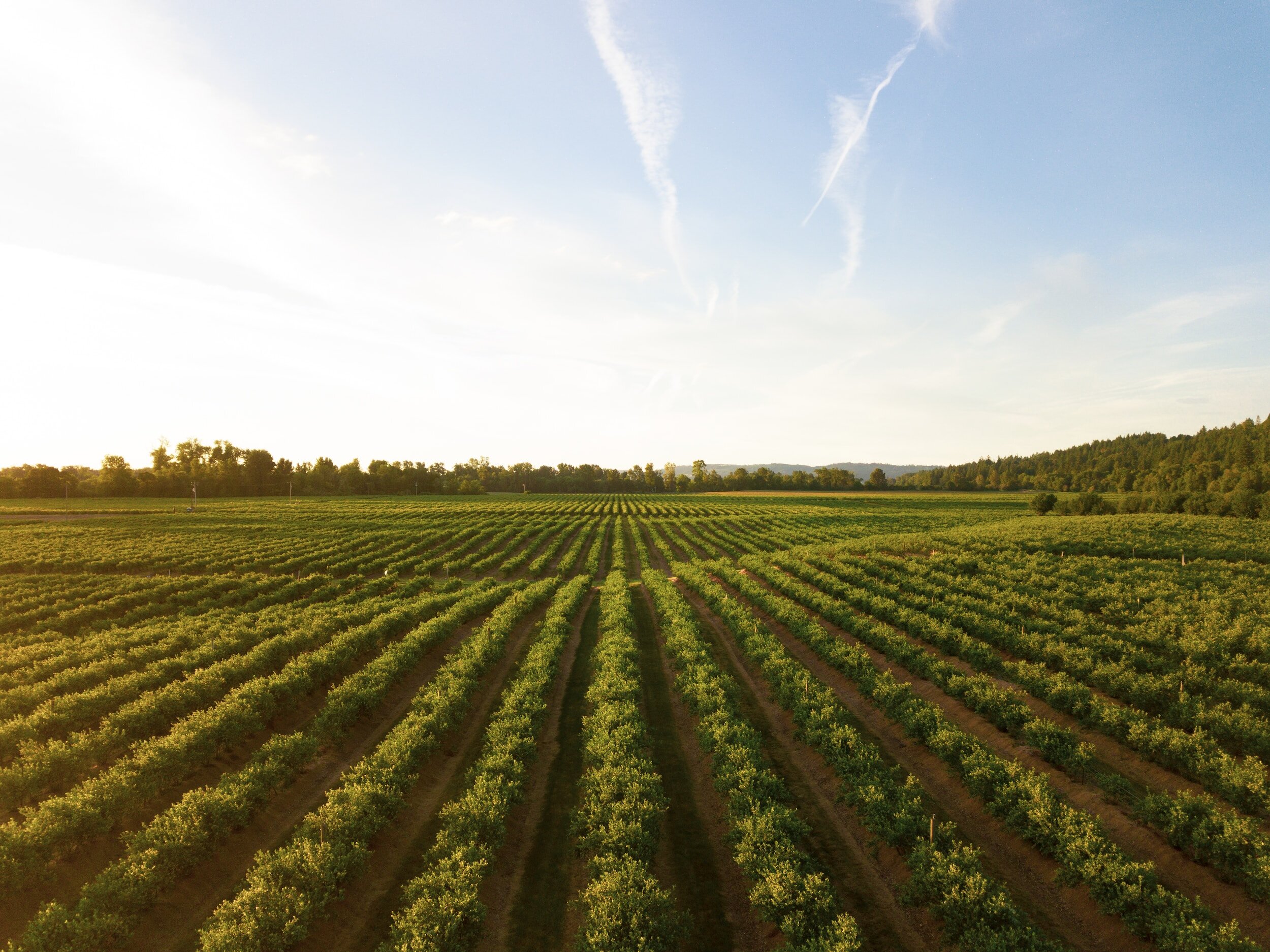
Both Cabernet Sauvignon and Cabernet Franc offer tempting options for red wine enthusiasts with their distinct characteristics.
Hosting a side-by-side tasting can be a fantastic way to appreciate and compare these two wines.
- Grab two bottles of similarly priced Cabernet Sauvignon and Cabernet Franc, invite friends over, and enjoy an evening of exploration and conversation.
Cabernet Sauvignon provides a bold and powerful experience, while Cabernet Franc offers elegance and herbal complexity.
Thirsty for More?
I’m a big believer in exploring different wines to expand your knowledge and palate. Here are some additional resources to enhance your wine journey:
Check out this post on Malbec vs Cabernet Franc, another popular red wine comparison, along with Cabernet Sauvignon vs Pinot Noir.
Here’s a helpful list of appetizers that are perfect for your next red wine tasting.




